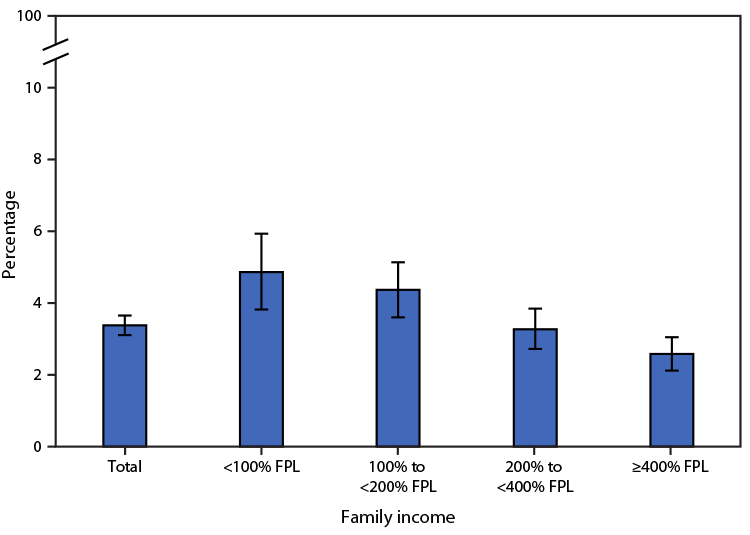QuickStats: Percentage* of Children and Adolescents Aged 3–17 Years Who Ever Received a Diagnosis of Autism Spectrum Disorder,† by Family Income,§ 2020–2022
Weekly / April 18, 2024 / 73(15);358
Altmetric:

Abbreviation: FPL = federal poverty level.
* Estimates are based on household interviews of a sample of the civilian, noninstitutionalized U.S. population, with 95% CIs indicated by error bars.
† Based on a “yes” response to the question, “Has a doctor or other health professional ever told you that [sample child] had autism, Asperger’s disorder, pervasive developmental disorder, or autism spectrum disorder?”
§ As a percentage of FPL, which is based on family income and family size, using the U.S. Census Bureau’s poverty thresholds. Family income was imputed when missing.
During 2020–2022, 3.4% of children and adolescents aged 3–17 years had received a diagnosis of autism spectrum disorder. The prevalence of autism spectrum disorder among children and adolescents decreased as family income increased.
Supplementary Table: https://stacks.cdc.gov/view/cdc/152917
Source: National Center for Health Statistics, National Health Interview Survey, 2020–2022. https://www.cdc.gov/nchs/nhis.htm
Reported by: Julie D. Weeks, PhD, jweeks@cdc.gov; Nazik Elgaddal, MS; Natalie Young, PhD.
Suggested citation for this article: QuickStats: Percentage of Children and Adolescents Aged 3–17 Years Who Ever Received a Diagnosis of Autism Spectrum Disorder, by Family Income, 2020–2022. MMWR Morb Mortal Wkly Rep 2024;73:358. DOI: http://dx.doi.org/10.15585/mmwr.mm7315a5.
For more information on this topic, CDC recommends the following link: https://www.cdc.gov/ncbddd/autism/index.html
MMWR and Morbidity and Mortality Weekly Report are service marks of the U.S. Department of Health and Human Services.
Use of trade names and commercial sources is for identification only and does not imply endorsement by the U.S. Department of
Health and Human Services.
References to non-CDC sites on the Internet are
provided as a service to MMWR readers and do not constitute or imply
endorsement of these organizations or their programs by CDC or the U.S.
Department of Health and Human Services. CDC is not responsible for the content
of pages found at these sites. URL addresses listed in MMWR were current as of
the date of publication.
All HTML versions of MMWR articles are generated from final proofs through an automated process. This conversion might result in character translation or format errors in the HTML version. Users are referred to the electronic PDF version (https://www.cdc.gov/mmwr) and/or the original MMWR paper copy for printable versions of official text, figures, and tables.
Questions or messages regarding errors in formatting should be addressed to mmwrq@cdc.gov.